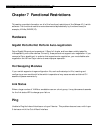
Cajun P220, P550, P550R Switch Release Notes, Release 4.0.1 16
Intelligent Multicasting
Problem: Intelligent Multicasting can block protocols to non-multicast routers. If you
have enabled Intelligent Multicasting and configured a VLAN attached to one or more
non-multicast routers or multicast-capable endstations, Intelligent Multicasting will
configure router ports where multicast-enabled routers reside. These multicast router
ports are necessary to allow all multicast packets to the adjacent multicast routers. Non-
multicast enabled routers will not be considered router ports, and will not receive
multicast traffic for which an Intelligent Multicast session was created. The problem can
arise when multiple IP multicast addresses map to the same multicast MAC address,
resulting in protocol packets not being sent to the adjacent non-multicast enabled
routers.
EXAMPLE:
The unicast routing protocol in use on all connected routers is OSPF, and all ports are on
the same VLAN. An endstation joins the IP multicast group 226.128.0.5 on port 1. The
MAC address for the group is 01:00:5E:00:00:05. IGMP snooping creates a session for
this MAC address, with port 1 as the client port. There is a non-multicast OSPF router
attached to port 2. OSPF uses the IP multicast link-scoped group 224.0.0.5, which also
maps to a MAC address of 01:00:5E:00:00:05. Because port 2 is not a router port, and it
is not part of the 01:00:5E:00:00:05 session, the switch will only pass OSPF messages out
port 1.
Other protocols, such as the Service Location Protocol (RFC 2608), use 224.0.1.22 and
224.0.1.35, which can be blocked by endstations joining sessions that map to the same
MAC address.
Workaround: Make certain that all ports connected to a router are configured as router
ports to ensure that all router-to-router messages will not be blocked. If other non-
router protocols such as the Server Location service are in use, create static sessions as
needed. Also, do not create static sessions that will conflict with the protocols in use on
your network. For a complete list of internet multicast addresses recognized by the
IANA, go to http://www.isi.edu/in-notes/iana/assignments/multicast-addresses.
NOTE: By default, the default “Rate Limiting” state for 10/100 Megabit ports is
Enabled, and multicast traffic is rate-limited (to 20%) on 10/100 Megabit ports. When
transmitted from these ports, multicast traffic is rate-limited unless Intelligent
Multicasting is enabled. If Intelligent Multicasting is enabled, the multicast traffic for
which the Intelligent Multicast session was created will not be subject to rate limiting
unless the rate limiting state is set to Enabled (all multicast included). If you do not
want to enable rate limiting of multicast traffic on a port, either 1)Enable Intelligent
Multicasting, or 2) Disable Rate-limiting on the port.


















